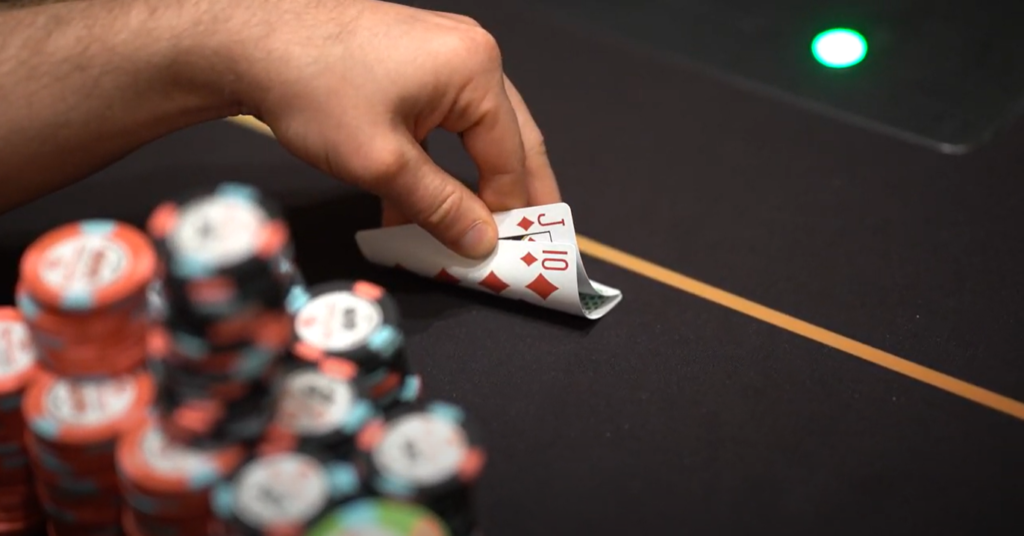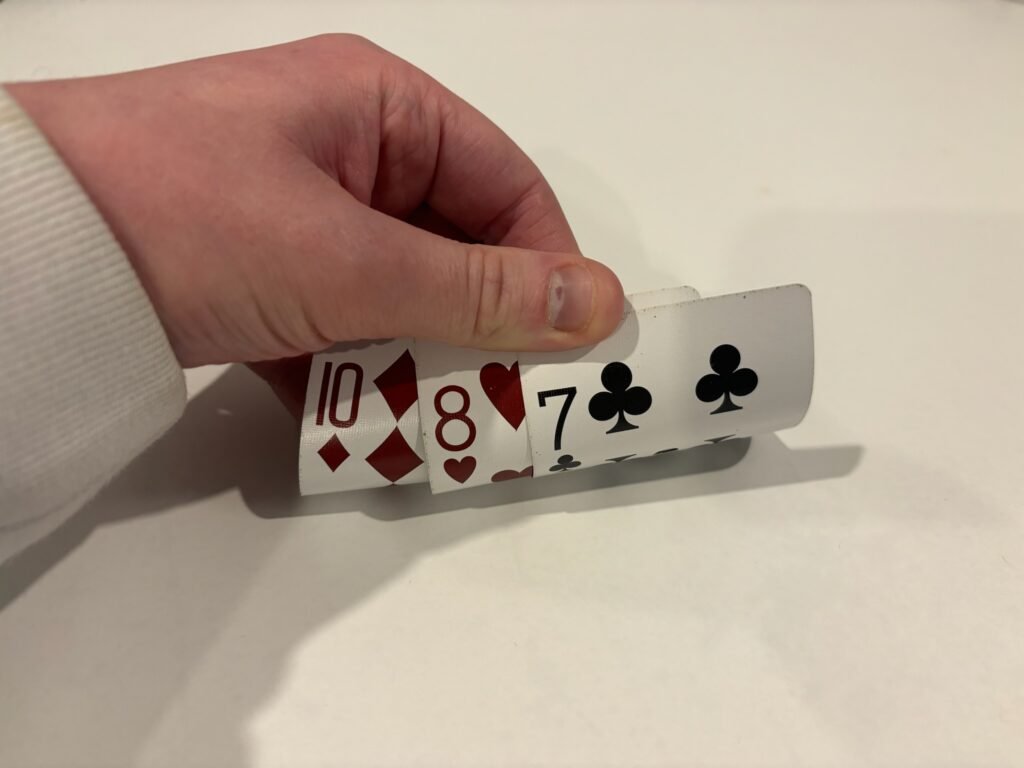One of the oldest poker games around, 7 Card Stud is a game on which some of the greatest players of all time built their careers and their names.
A somewhat simpler form of poker than Texas Hold’em, 7 Card Stud poker is a game played without any community cards and with limit-style betting, which makes gameplay drastically different from the big bet games.
Today, we are going to look at 7 Card Stud poker rules, starting from the most basic ones, to help players who have not had a chance to learn how to play this game before getting a head start.
If you are new to 7 Card Stud and are looking to learn the basics, keep reading as we explain the basic rules and goals of the game, the betting streets, and everything else you need to know about it.
Basic Rules of 7 Card Stud Poker
Instead of getting shared community cards, players are dealt their own unique board, each potentially containing up to seven cards.
This setup caps the Stud table at eight players. Despite receiving seven cards in 7 Card Stud, the winning hand still relies on the best 5-card combination from a player’s personal board, which is formed in accordance with the standard poker hand rankings.
The game typically follows a fixed-limit structure: the initial two betting rounds use the smaller bet, while the final three rounds (with the fifth, sixth, and seventh cards) involve the larger bet, also known as the big bet.
Should the fourth card reveal an open pair, players have the choice to escalate the stakes to the larger bet amount.

Unlike Texas Hold’em where you only receive two cards, in Stud you receive seven!
Playing Seven Card Stud – Antes, Bring-In, and Betting Streets
Unlike games like Texas Hold’em and Pot Limit Omaha, which are played with blinds, Seven Card Stud is played with antes and a bring-in.
Each player at the table is forced to post an ante bet at the start of the hand, with the player who receives the lowest up-card during the initial deal posting an additional compulsory bet known as the bring-in.
Step #1. Third Street in 7 Card Stud Poker
Third street is the first betting street in 7 Card Stud, but it is called third street as the first three cards are all available at this point.
Once the antes are posted, the dealer deals three hole cards to each player, two of them face down and the last one face up.
The up-card determines which player posts the bring-in, with the lowest card always having to bring-in, while other players get to act on their hand in order they are seated.
Each player is given an opportunity to complete a small bet (the bring-in is valued at half a small bet) or raise the bet, with up to four total bets allowed on third street.
Once all third street betting is completed, the dealer deals a fourth hole card to each player at the table face up, taking us to the fourth street.
Step #2. Fourth Street in 7 Card Stud Poker
Once the fourth hole card is dealt to all the active players, fourth street betting can commence. Like on third street, the betting limit still increases in increments of small bets, which means up to four small bets are allowed on this street.
This time around, the player with the strongest hand showing gets to act first. If no player has a pair showing, the one with the highest up-card will act first.
If a player does have an exposed pair, they are allowed to make a big bet instead of a small bet if they so choose, allowing them to better protect their hand.
The action goes around the table, with each remaining player acting on their hand. Once all the players have acted and up to four bets have been made, the fifth card is dealt.
Step #3. Fifth Street in 7 Card Stud Poker
The dealer deals the fifth hole card to each active player, and another round of betting starts. Once again, the player showing the strongest hand gets to go first.
Note that the betting order in Seven Card Stud can change between betting streets as new cards are dealt and players’ hands change.
It is also important to note that the player going first does not necessarily have the best hand, as only the up cards count toward the decision of who plays first.
On fifth street, the betting limit goes up, and bets are made in increments of big bets, which means the pot can now get significantly bigger in relation to earlier betting rounds.
Since the big bet now kicks in, fifth street is usually the time to stop chasing after bad draws and decide if your hand is strong enough to stand the heat down to seventh street.
Step #4. Sixth Street in 7 Card Stud Poker
Sixth street comes after the dealer deals the sixth hole card to each player. This is the fourth and final up card dealt to each player, before the seventh card is dealt face down.
On the sixth street, the big bet is still in play, while the player with the strongest showing hand gets to act first like before.
Typically speaking, the playing field will be thinned out by sixth street, with just two or three players remaining to this point. Most of the time, players who play through fifth street also call a bet on sixth street, before re-evaluating on the seventh.
Step #5. Seventh Street in 7 Card Stud Poker
Seventh street is the final betting round in 7 Card Stud, also known as “river.” This last betting round comes about after the dealer deals the final hole card to each player.
Note that the seventh card is dealt face down, making each player’s hand now consist of three down cards and four up cards.
The betting order remains the same as on sixth street, as the same player will have the strongest hand showing on these two streets in every case.
Players get to make bets in big bet increments on seventh street, and once all betting is completed, the dealer announces showdown.
Step #6. Showdown in 7 Card Stud Poker
Once all the seven cards have been dealt and all the betting has been completed, the dealer announces showdown.
At this point, players must turn over their hole cards and show their entire seven card hands. The dealer will compare the hands according to poker hand rankings and decide on the winner.
If two or more players have the exact same hand, the pot will be split. If two or more players have a flush, the player with the higher flush will win the hand, regardless of the suits, which don’t play a role in anything but determining the bring-in at the start of the hand.

Elite poker pros like Nick Schulman have built careers off of games like Seven Card Stud.
Seven Card Stud Poker Hand Rankings
Now that we have gone over the way Seven Card Stud is played and its basic poker rules, it’s time to take a look at the standard hand rankings used in this game.
Seven Card Stud poker uses the traditional set of hand rankings, which means players transitioning from games like Texas Hold’em will already know which hands beat which. However, if you are new to poker and learning Seven Card Stud poker rules as your first poker game, then keep reading and find out what the best hands are.
Remember, despite having a total of seven cards in this game, you will be looking to make a five card hand, with the following hands possible, from best to worst:
- Royal Flush: A♠K♠Q♠J♠T♠
- Straight Flush: T♦9♦8♦7♦6♦
- Four of a Kind: 5♠5♥5♦5♣K♦
- Full House: J♠J♦J♣7♥7♣
- Flush: A♣J♣8♣6♣2♣
- Straight: 9♠8♥7♣6♥5♣
- Three of a Kind: 8♠8♦8♣J♥3♦
- Two Pair: Q♥Q♦9♥9♦4♠
- One Pair: A♦A♣T♥6♦3♣
- High Card: K♠J♦8♠6♥2♣
Note that more than one player can have the same hand ranking, such as one pair, two pair, or three of a kind in 7 Card Stud.
In such a situation, the player with the higher pair, two pair, three of a kind, straight, or flush, will win the hand. If two players have the exact same hand, such as a pair of Aces, their next highest card, called “kicker,” will decide who wins the hand.
There can also be examples when more than one kicker needs to be used as players have the same pair and the same kicker, in which case the next highest card comes into play.
Best Starting Hands in Seven Card Stud
Simply knowing 7 Card Stud poker rules won’t be enough to see you win in any respectable lineup, so we need to talk at least briefly about some strategy as well.
To start with, it’s worth looking at Seven Card Stud starting hands that you should play and the way in which you should play them.
The first thing you will want to do before you even look at your cards is take a look around the table and notice all the up cards that were dealt.
Knowing every card that was dealt face up and then folded will help you greatly with assessing your odds on later streets and deciding when you can profitably continue with your hand.
Once you have seen and memorized all the up cards, you can proceed to look at your own cards and decide how playable your hand is.
Typically speaking, you will want to have at least a pair or three suited or connected cards to enter a 7 Card Stud pot, especially from early positions.
With many players to act after you, you should not be opening a pot with small pairs either and should generally only be looking to get involved when your cards are really strong.
The strongest hands you can have to start with in Seven Card Stud are rolled up trips (three of a kind), which all but guarantee you have the best hand at the moment.
A big pocket pair in the hole (both cards face down) can also be a very powerful hand, as you get to disguise its strength on early betting streets.
Suited and connected hands with high cards like A♥ K♥ Q♥ are also very powerful as they stand to win in many different ways by showdown.
On the other hand, hands like T♦ 8♣ 7♠, which many amateurs will often play, are really only good for a steal attempt when most other players at the table have folded their cards, and even then, you should make sure that the cards that could improve your hand have not yet been folded.
Playing fairly tight is the name of the game in Seven Card Stud, as too much of your hand is exposed to your opponents, and bluffing opportunities are limited.
For that reason, starting with a reasonable set of starting hands will give you a chance to hold your own and still use some bluffing opportunities as they arise.

Starting hands like T-8-7 are best used for steal attempts, as they are not that strong.
Playing Your First Seven Card Stud Game
These days, Seven Card Stud is a game that’s not spread too often, but you will still find it in some live casinos and some online poker rooms, especially in tournament format.
When you sit down to play your first game, remember the Seven Card Stud rules you learned here first before you proceed to try anything too fancy.
Play tight and only enter pots with strong hands early on while watching more experienced players play and learning poker strategy straight from them.
Seven Card Stud is a game that’s relatively easy to become decent at, but it may take a long time before you are a master of the game and a player who takes every spot there is.
We recommend taking it slow, learning from experience, and studying the game away from the table to find all the spots in which you could have maximized your value and won more than you actually did.